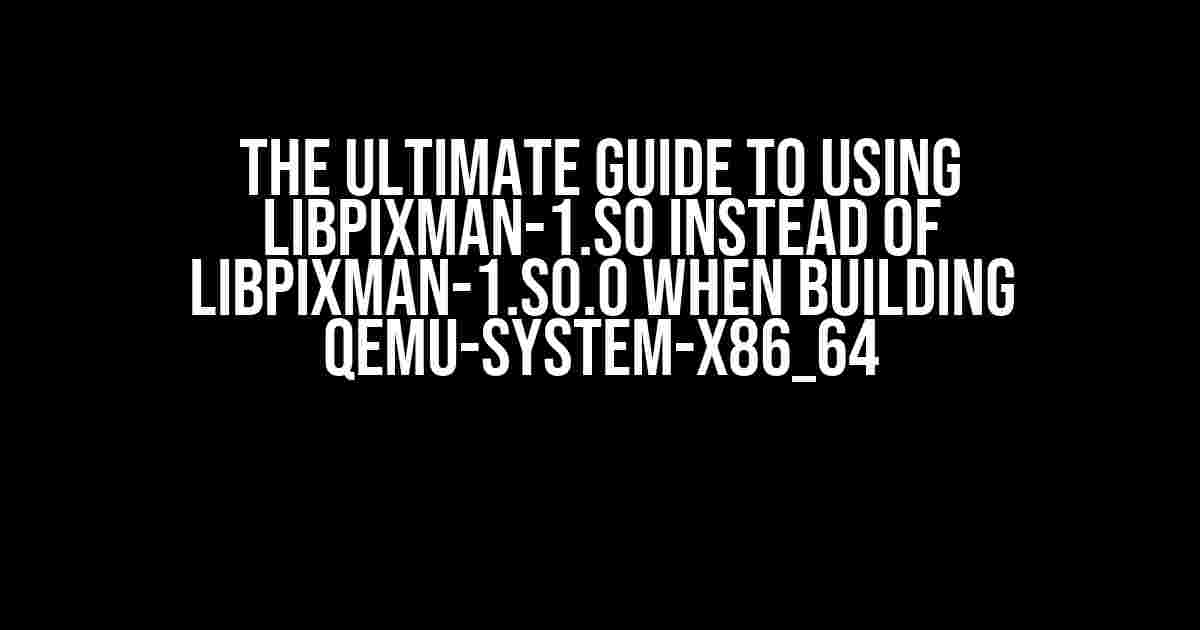Are you tired of dealing with the dreaded libpixman-1.so.0 error when building QEMU-System-X86_64? Do you want to know the secret to using libpixman-1.so instead? Look no further! In this comprehensive guide, we’ll take you by the hand and walk you through the process of configuring your build to use the newer, better libpixman-1.so library.
- What’s the Difference Between libpixman-1.so and libpixman-1.so.0?
- Step 1: Check Your System Configuration
- Step 2: Update Your QEMU-System-X86_64 Build Configuration
- Step 3: Re-Run the Configure Script
- Step 4: Build and Install QEMU-System-X86_64
- Step 5: Verify the Changes
- Troubleshooting Common Issues
- Conclusion
What’s the Difference Between libpixman-1.so and libpixman-1.so.0?
Before we dive into the how-to, let’s take a quick detour to understand the what and why. libpixman-1.so and libpixman-1.so.0 are both shared object files used by QEMU-System-X86_64 to render graphics. The main difference between the two lies in their versioning:
libpixman-1.so.0is an older version of the library, which is often deprecated in newer systems.libpixman-1.sois a newer version, which provides improved performance, security, and compatibility.
Using the newer libpixman-1.so library can resolve issues with rendering, improve overall system stability, and even boost performance. So, why not use it?
Step 1: Check Your System Configuration
Before we begin, make sure your system is configured to use the correct libraries. Open a terminal and run the following command:
ldconfig -p | grep libpixmanThis command will display a list of installed libpixman libraries on your system. Take note of the versions available.
Step 2: Update Your QEMU-System-X86_64 Build Configuration
Now, let’s update the QEMU-System-X86_64 build configuration to use libpixman-1.so instead of libpixman-1.so.0. Open the configure script in your favorite text editor:
vim ./configure.acAdd the following line to the LIBPIXMAN_CFLAGS section:
LIBPIXMAN_CFLAGS="-I/usr/include/pixman-1 -L/usr/lib/x86_64-linux-gnu"This sets the include path and library path to use the newer libpixman-1.so library.
Step 3: Re-Run the Configure Script
Run the configure script again to re-generate the build configuration:
./configure --target-list=x86_64-softmmu --enable-kvm --enable-vnc --prefix=/usr/local/qemuMake sure to include the necessary options for your build, such as enabling KVM and VNC support.
Step 4: Build and Install QEMU-System-X86_64
Now that the configuration is updated, let’s build and install QEMU-System-X86_64:
make && make installThis may take some time, depending on your system’s resources.
Step 5: Verify the Changes
Once the installation is complete, verify that QEMU-System-X86_64 is using the correct library:
ldd /usr/local/qemu/bin/qemu-system-x86_64 | grep libpixmanThis command should display the correct version of libpixman-1.so being used.
Troubleshooting Common Issues
Encountered errors during the build process? Don’t worry, we’ve got you covered! Here are some common issues and their solutions:
| Error Message | Solution |
|---|---|
configure: error: Cannot find libpixman-1.so |
Install the libpixman-1-dev package and re-run the configure script. |
make: *** No rule to make target 'all' |
Run make clean and then re-run the build process. |
/usr/local/qemu/bin/qemu-system-x86_64: error while loading shared libraries: libpixman-1.so: cannot open shared object file: No such file or directory |
Update the LD_LIBRARY_PATH environment variable to include the path to the libpixman-1.so library. |
By following these steps and troubleshooting common issues, you should now be able to successfully use libpixman-1.so instead of libpixman-1.so.0 when building QEMU-System-X86_64.
Conclusion
In conclusion, using libpixman-1.so instead of libpixman-1.so.0 can significantly improve the performance and stability of your QEMU-System-X86_64 builds. By following this comprehensive guide, you’ll be well on your way to configuring your build to take advantage of the newer, better library.
Remember to stay up-to-date with the latest developments in the QEMU and libpixman communities, and don’t hesitate to reach out for support if you encounter any issues.
Additional Resources
Need more information or guidance? Check out the following resources:
Happy building!
Frequently Asked Question
Get ready to dive into the world of QEMU building and learn how to use libpixman-1.so instead of libpixman-1.so.0!
What is the main reason to use libpixman-1.so instead of libpixman-1.so.0 when building qemu-system-x86_64?
The main reason is to avoid version-specific dependencies and ensure compatibility with different Linux distributions. libpixman-1.so is a symbolic link to the actual library, which can be libpixman-1.so.0 or any other version. By using the symbolic link, you can build qemu-system-x86_64 without worrying about the specific version of libpixman.
How do I specify the library name when building qemu-system-x86_64?
You can specify the library name using the --with-pixman=libpixman-1.so flag when running the configure script. This flag tells the build system to use libpixman-1.so instead of libpixman-1.so.0.
What if I’m using a build system like cmake or meson?
If you’re using a build system like cmake or meson, you’ll need to modify the build configuration files to specify the library name. For example, in cmake, you can add the following line to your CMakeLists.txt file: link_directories(/usr/lib/x86_64-linux-gnu/) and link_libraries(libpixman-1.so). In meson, you can use the pixman_dep dependency and specify the library name as libpixman-1.so.
Will using libpixman-1.so instead of libpixman-1.so.0 affect the performance of qemu-system-x86_64?
No, using libpixman-1.so instead of libpixman-1.so.0 should not affect the performance of qemu-system-x86_64. The symbolic link points to the same library, so the performance should be identical. The only difference is that you’ll be using a version-independent library name, which can make your build more portable and flexible.
What are the potential pitfalls of using libpixman-1.so instead of libpixman-1.so.0?
One potential pitfall is that the symbolic link may point to a different version of the library than the one you expect. For example, if the system has multiple versions of libpixman installed, the symbolic link may point to a newer or older version than the one you want to use. To avoid this, make sure to verify the library version and its compatibility with your qemu-system-x86_64 build.


